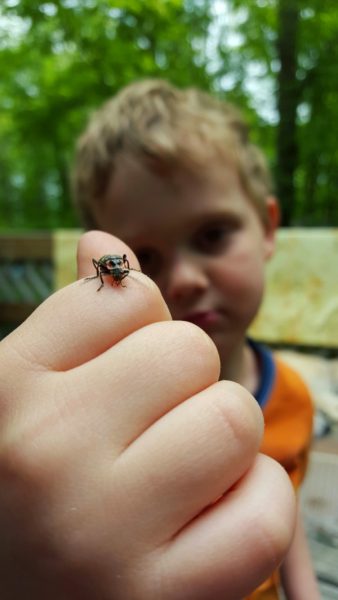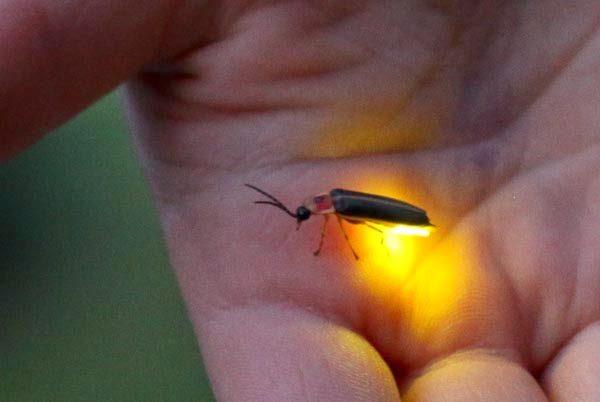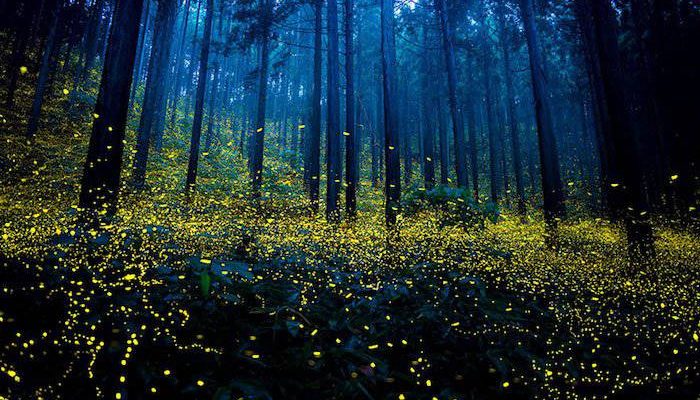Summer brings out the bugs. Nasty skeeters, biblical plagues of cicadas, and that cricket that lived in my car for nine days one year and almost chirped me into the nuthouse. As a culture, we spend hundreds of millions of dollars to deal with insects and their unwelcome presence in our lives. Yet, every June, an outbreak of the most beloved kind occurs right in our backyards. Scientists call them Lampyridae, a family of insects in the order Coleoptera.
In other parts of the country, they’re known as fireflies. Here in West Virginia and most of the eastern US, we call them lightning bugs, and right now, the sweet little beetles with the light-up butts are conducting their annual mating ritual in our backyards, to the delight of porch-sitters across the Ohio Valley and beyond.
I’ve been sitting on the deck each night, watching their miraculous evening ritual. My kids catch and release them, and we examine the big ones and the small ones, giving them names and sending them back into the twilight to complete their mission. That mission is simple: find a mate, reproduce, and die. Like so many insects, they exist as adults for only a few weeks, and before we know it, they’re gone for another year.
There are over 2,000 species of firefly in the world, and 136 exist in North America. They overlap, so the individuals you see in your yard vary. A chemical reaction within the insects creates the bioluminescent glow, and the larvae too can glow to signal their distastefulness to predators. Scientists believe the beetles developed their ability to light up as a warning, but it became a way to attract a mate. Females on the ground spend considerable time watching the flying males’ flashes. When they see a display they like (the brighter and flashier the better, often), they signal in return, and a match is made. The female will lay about 100 eggs and the larvae will spend the winter—sometimes several—underground before emerging in the spring to continue their life cycle.
We’ve got about 15 species of firefly here in the Mountain State. While our Wheeling beetles flash at random, in the Allegheny Forest and the Great Smoky Mountains, a synchronous firefly species attracts human visitors each year. The insects gather in massive swarms and flash in unison, as though the world’s largest string of Christmas lights has been hung in the forest. Visitors to Great Smoky Mountain National Park actually line up and buy tickets to see this annual show.
Lightning bugs naturally create such joyful memories. When I was a kid, lightning bugs meant late June evenings with the next-door neighbors. Humid air, a fading purple twilight, and soft grass on bare feet. The first tentative lights winked on each night in the peony bushes, and as the darkness descended, a bioluminescent symphony overtook the yard. We caught them, studied them, and released them. For those injured individuals with a misshapen wing or a broken antenna, perhaps, we created a lightning bug hospital. Located on an old stump, it was a quiet place for rehabilitation where we, the 7-year-olds, petted them and gave them sympathy and a pep talk: “It’s okay, lightning bug. It’s going to be fine, lightning bug. Here, lightning bug, let me squeeze you tight and love you until you’re all better!”
Looking back, our success rate with firefly rehab was depressingly low.
But the memories stuck with me, and my kids and I still wait for the fireflies each June when the daylight lingers until almost 10 o’clock. Kids and fireflies just naturally seem to go together, though it’s helpful to supervise the activity to protect the insects.

However, the grubby hands of children may not be the fireflies’ biggest threat. There’s a dark side to all this lovey-dovey memory-making. While the lightning bug dating event appears sweet and joyful to us, down on the ground, there’s drama playing out. As the males wander about and signal for mates, hungry females of another species will often lurk in the grass and assume a false identity to lure the males in. It’s catfishing* for fireflies, if you will. Females of the species Photuris have learned to mimic the flashing patterns of Photinus females. Just when an eager Photinus fellow thinks he’s found his soulmate, he’s pounced upon and devoured. Scientists call the Photuris females “femme fatale fireflies.” These femme fatales can switch between signals of different species, so the cannibalistic dining possibilities are endless. They can even absorb defensive compounds (the kind that makes them taste terrible to a predator) from other species for protection and pass this protection to their eggs. Meanwhile, certain males have caught on and are developing their own bioluminescent tricks in response to the females’ deception.
It’s a jungle out there.
Still, despite their tough side, lightning bug populations are diminishing around the world. Scientists attribute this decline to habitat destruction. Firefly larvae grow in moist and humid places like rotting wood, forest litter, and along bodies of water like ponds and marshes. As we continue to develop forested lands and wetlands, we’re rapidly paving over their nurseries. Even boat traffic along a waterway can damage firefly populations.
In addition, the beetles suffer from a second problem: light pollution. The brighter we make our world at night, the harder it is for the insects to reproduce. Our lights blind them and throw their flashes out of sync. Brighter lights from the human world correspond with what scientists deem a “failure to mate.”
To this end, I’ve seen fewer lightning bugs as I’ve aged. Some summers we’ve had a scant number; others, like this year, we’ve had a healthy population, but overall the trend is downward. So how can you provide a suitable habitat for lightning bugs in your own yard? Given that they don’t venture far from the place where they hatch, a decrease in your backyard blinky-bugs may mean that you’ve got too many lights on. Turn off garden and landscaping lights at night. Turn off security lights, at least during lightning bug mating season. Draw the drapes after dark, too. (This is good practice anyway because, quite frankly, we’re all sick of watching you eat raw cookie dough out of the package in your underwear at 11 o’clock each night.)
A moderate change in your landscaping habits can also help to increase firefly habitat in the backyard. Plant native trees, as this will encourage the health of all native species. Let a small portion of your lawn grow wild; fireflies tend to struggle in heavily-manicured yards. The insects will lay their eggs in leaf litter or rotting logs. Just a few natural places in the yard can increase habitat. Water features such as ponds may also help.
Consider eschewing pesticides on the lawn. By now we all know the devastating effect that chemicals have on our bee populations, and we desperately need our bees. These toxins don’t discriminate. Your lighting bugs, and your beneficial bugs like ladybugs, too, are at risk. Ask your lawncare company about a natural alternative.

Now that we’ve passed the summer solstice, the fireflies’ mating ritual will quickly diminish. Summer speeds by here in the Ohio Valley, and our time with our glowing friends is even shorter. If you haven’t already done so, spend an evening on your porch. Put away the tablets, the cell phones, and the video games. Turn off the lights. Watch the sun sink away and wait for the first tiny glow of the evening. One flash becomes two becomes thousands, together.
They’ll be gone soon, leaving behind a new generation, so sit and enjoy the lightning bugs. Though their time is short, our memories of them will be long.
*To catfish is to assume a fictional online personality, usually to pursue a deceptive romantic relationship.




